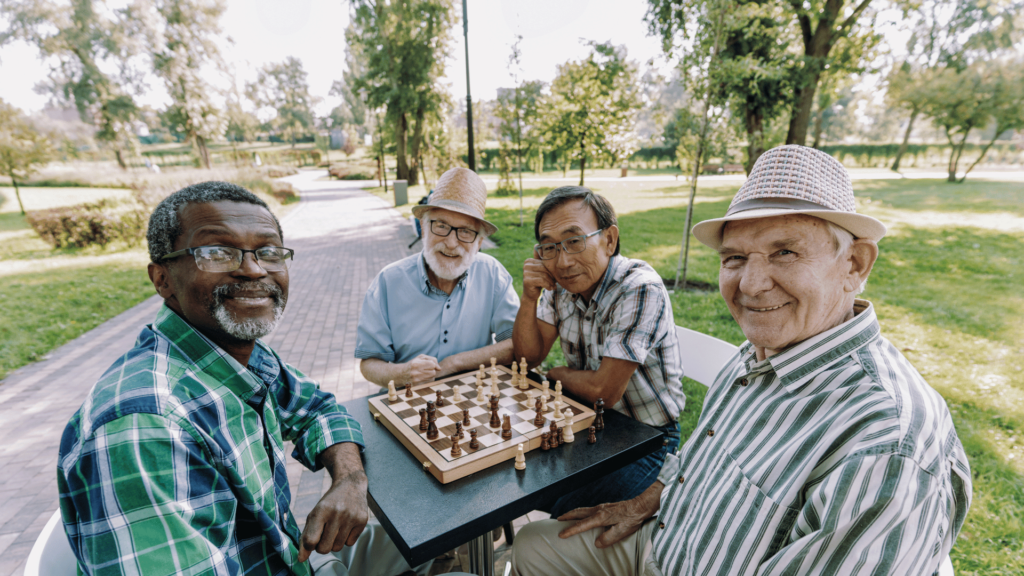The Benefits of
Intergenerational Programming
In the heart of every vibrant assisted living community lies a potential for connection that transcends age. Intergenerational programming, the intentional practice of bringing together seniors and younger generations, is more than just a passing trend; it’s a powerful approach to enhancing well-being, fostering mutual respect, and creating lasting memories. In this blog post, we delve into the myriad benefits of intergenerational programming and explore how it transforms the lives of both seniors and youth.
The Silent Epidemic: Combating Loneliness and Isolation
Loneliness and social isolation are pervasive issues among older adults, often exacerbated in assisted living settings. Studies have shown that social isolation can have significant negative impacts on physical and mental health, increasing the risk of depression, cognitive decline, and even mortality. Intergenerational programs serve as a potent antidote to this isolation, providing seniors with regular opportunities for meaningful interaction and connection.
- Sense of Purpose and Belonging: Engaging with younger generations can rekindle a sense of purpose for seniors, reminding them that they are valued members of the community. Sharing stories, imparting wisdom, and participating in collaborative activities can instill a feeling of belonging and reduce feelings of loneliness.
- Enhanced Social Interaction: Intergenerational activities provide structured opportunities for social interaction, fostering friendships and connections that may otherwise be difficult to cultivate. Regular engagement with children and young adults can break down social barriers and create a lively, engaging atmosphere.
- Emotional Well-being: The joy and vitality of children and young adults can be infectious. Their presence can bring smiles, laughter, and a renewed sense of optimism to seniors, improving their overall emotional well-being.
Cognitive Stimulation and Mental Agility
Maintaining cognitive function is crucial for healthy aging. Intergenerational programs offer a unique form of cognitive stimulation that can help seniors stay mentally sharp.
- Mental Engagement: Activities like storytelling, games, and collaborative projects require seniors to engage their minds, recall memories, and think creatively. These mental exercises can help maintain cognitive agility and slow down the progression of cognitive decline.
- Learning and Sharing: Seniors possess a wealth of knowledge and life experiences. Sharing these stories and skills with younger generations can be a rewarding experience for both parties. It keeps seniors mentally active and provides valuable learning opportunities for youth.
- New Perspectives: Engaging with younger generations exposes seniors to new ideas, technologies, and perspectives. This exposure can help them stay mentally flexible and adapt to a rapidly changing world.

Physical Health and Vitality
Intergenerational activities can also have significant physical benefits for seniors.
- Increased Physical Activity: Many intergenerational programs incorporate physical activities like gardening, dancing, or light exercise. Engaging with energetic young people can motivate seniors to stay active and improve their physical fitness.
- Reduced Stress: The positive emotions generated by interacting with children and young adults can help reduce stress levels and promote relaxation. Laughter and playfulness can have a therapeutic effect, lowering blood pressure and improving overall physical health.
- Improved Mobility: Activities that require movement, such as dancing or playing games, can help seniors maintain their mobility and prevent falls.
The Benefits for Younger Generations
Intergenerational programming is not solely beneficial for seniors; it also provides valuable experiences for children and young adults.
- Developing Empathy and Compassion: Interacting with seniors can help young people develop empathy, compassion, and a greater understanding of aging. They learn to appreciate the wisdom and experiences of older adults and challenge ageist stereotypes.
- Building Interpersonal Skills: Intergenerational activities provide opportunities for young people to practice their communication and social skills. They learn to interact with individuals from different generations, fostering patience, respect, and understanding.
- Learning from History: Seniors offer a unique window into the past, sharing stories and perspectives that can enrich the learning experience for young people. They can learn about historical events, cultural traditions, and personal experiences that are not found in textbooks.
- Gaining a Sense of Community: Participating in intergenerational programs can help young people develop a stronger sense of community and belonging. They learn to appreciate the value of intergenerational connections and the importance of supporting older adults.
Creating Meaningful Experiences: Program Ideas
Implementing successful intergenerational programs requires careful planning and consideration. Here are some ideas for activities that can foster meaningful connections:
- Storytelling and Oral History Projects: Seniors can share their life stories, while young people can record and document these narratives.
- Arts and Crafts Workshops: Collaborative art projects, such as painting, pottery, or crafting, can provide opportunities for creativity and interaction.
- Gardening and Nature Activities: Working together in a garden or exploring nature can be a relaxing and rewarding experience.
- Music and Performance: Singing, playing instruments, or performing plays can bring joy and entertainment to both generations.
- Games and Recreation: Board games, card games, and outdoor games can promote laughter and friendly competition.
- Technology Workshops: Young people can teach seniors how to use technology, such as smartphones, tablets, and computers.
- Cooking and Baking: Sharing recipes and cooking together can create a sense of camaraderie and shared accomplishment.
- Reading and Book Clubs: Reading stories aloud or discussing books can stimulate conversation and foster a love of literature.
- Mentoring and Tutoring: Seniors can mentor young people in academic subjects or life skills, while young people can provide tutoring or assistance with technology.
Community Service Projects: Working together on community service projects, such as volunteering at a food bank or cleaning up a park, can foster a sense of shared purpose.
Building a Culture of Intergenerational Connection
To maximize the benefits of intergenerational programming, assisted living communities must cultivate a culture that values and promotes these connections.
- Dedicated Staffing: Designate staff members to coordinate and facilitate intergenerational programs, ensuring that activities are well-planned and engaging.
- Regular Scheduling: Integrate intergenerational activities into the regular schedule, making them a consistent part of the community’s programming.
- Community Partnerships: Collaborate with local schools, youth organizations, and community groups to develop sustainable intergenerational programs.
- Accessible Spaces: Create welcoming and accessible spaces that encourage interaction between seniors and younger generations.
- Evaluation and Feedback: Regularly evaluate the effectiveness of intergenerational programs and solicit feedback from participants to ensure continuous improvement.
Conclusion
As our society ages, the importance of intergenerational connections will only grow. Assisted living communities that embrace these programs will be at the forefront of providing holistic and enriching care for seniors. By bridging generations, we can create a more compassionate, inclusive, and joyful world for everyone.
Intergenerational programming is more than just a feel-good activity; it’s a vital component of creating a thriving and supportive assisted living environment. By fostering meaningful connections between seniors and younger generations, we can break down barriers, combat loneliness, and create a legacy of love, respect, and understanding.
Latest Blogs
The Importance of Male Friendships in Senior Communities
Moving into an assisted living community represents a significant life transition. While…
Maintaining Mental Wellness in Assisted Living
Moving into an assisted living community represents a significant life transition. While…
Strategies for Supporting a Loved One with Dementia or Alzheimer’s
Dementia and Alzheimer's disease present unique challenges, not only for the individuals…



